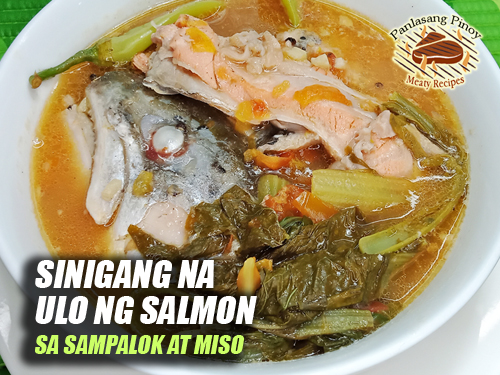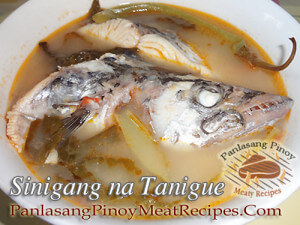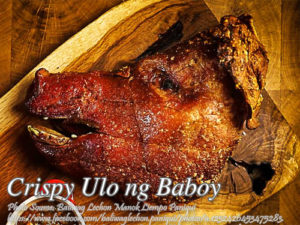Sinigang na ulo ng salmon is somewhat a new dish because it was no yet popular decades ago and salmon is not an indigenous fish. It was an imported fish from Western or European countries and the reason why it it now available locally is because countries selling this fish only eat the fleshy part and cut off the head and dispose of it.
Compared to the salmon steak or fillet, salmon head is cheaper so it can be bought by the average Pinoys like me. And can’t think of any dish suitable for salmon head than making into sinigang because it is mostly bones and cartilage. Anyway since salmon head is really fishy so it should be seared or fried lightly before cooking it into sinigang dish to remove the fishy taste. So I’m sure you are going to like this dish if you one of your favorite dish is sinigang.
A Tangy, Flavorful Twist on a Filipino Classic
When you think of traditional Filipino comfort food, the dish that often comes to mind is sinigang. This sour soup, with its unmistakable tamarind tang and a medley of fresh vegetables, has been a staple in Filipino kitchens for generations. Typically made with pork, shrimp, or milkfish, sinigang is versatile and beloved by many. But recently, a new variation has made waves—one that uses salmon head, a relatively modern twist on this classic. This version of sinigang brings together the rich, fatty goodness of salmon head with the familiar sour broth, enhanced by a touch of miso for extra depth of flavor.
The Curious Journey of Salmon to Filipino Kitchens
You might be wondering, how did salmon, a fish commonly found in the icy waters of the Atlantic and Pacific, make its way to the Philippines? Salmon is not native to tropical waters, which makes it a relatively recent addition to Filipino cuisine. Historically, it wasn’t something you would find in local wet markets. However, as global trade increased, imported salmon became more accessible to the average Filipino. Interestingly, countries that export salmon typically prioritize the fillets, leaving the heads as by-products. Luckily for us, these heads are often sold at a fraction of the cost of fillets, making them an affordable option for creating this flavorful dish.
Why Salmon Head is Perfect for Sinigang
Using salmon head in sinigang is more than just a budget-friendly choice. The head of the fish, while not as meaty as the fillet, brings a gelatinous richness due to the collagen in the skin and cartilage. This contributes to a unique texture and deeper flavor profile in the soup, making it a perfect match for the sour broth. Since the head is quite bony, it doesn’t lend itself well to other cooking methods like grilling or frying, but it shines in a slow-simmered soup like sinigang where it can fully release its umami-rich oils into the broth.
One challenge, though, is the fishy aroma that can sometimes overpower the dish. To tackle this, the salmon head is lightly fried before it’s added to the soup. This quick sear helps seal in the fish’s natural juices while taming the strong fishy odor, ensuring that the broth maintains its delicate balance of flavors.
The Flavor Boost from Miso and Sampalok
What sets this particular version of sinigang apart from others is the addition of miso, a fermented soybean paste. While not traditionally part of Filipino sinigang, miso adds an umami depth that pairs wonderfully with the natural richness of the salmon head. The combination of the sour sampalok (tamarind) and the earthy, salty miso creates a more nuanced broth that elevates the dish beyond the usual tanginess.
Incorporating miso into Filipino cuisine may seem unconventional, but it speaks to the evolving nature of Filipino food. Much like how sinigang itself has adapted to include various proteins and regional ingredients, this version shows how Filipino cooking continues to innovate while still holding on to its core flavors.
Cooking Tips for the Perfect Sinigang Soup
The key to making this dish shine is in how you handle the salmon head. Begin by cleaning it thoroughly, removing the gills and giving it a good rinse. The quick fry, as mentioned earlier, helps keep the head intact while also reducing any overly strong fishy notes. It’s also essential to use fresh aromatics like garlic, onion, and ginger to build a strong flavor base for the soup.
When simmering the broth, don’t rush the process. Allow the vegetables, particularly the tomatoes, to soften and release their juices fully. The use of rice washing as the soup base is a common trick in Filipino households—it gives the broth a subtle starchiness that rounds out the flavors.
Finally, add your leafy greens like mustard leaves towards the end of the cooking process. These vegetables wilt quickly and don’t need more than a couple of minutes in the broth. The last thing you want is overcooked greens that turn mushy. You’ll also want to serve this dish piping hot, as it’s best enjoyed warm, with steamed rice on the side.
A Filipino Classic with a Modern Twist
Though sinigang has been a part of Filipino culture for centuries, using salmon head is a relatively modern innovation. It’s a dish that embodies the creativity of Filipino cooks, finding new ways to incorporate global ingredients into traditional dishes. The affordability of salmon head, combined with the familiar sour notes of sinigang, makes this a go-to dish for many home cooks. Whether you’re a fan of seafood or just looking to try something new, this dish offers a satisfying and heartwarming meal that will have you coming back for seconds.
While it’s not the typical sinigang your grandparents might have grown up with, it still carries the same spirit of comfort and home. So next time you see salmon heads available at your local market, don’t hesitate to grab one and try this modern take on a beloved Filipino classic. Your taste buds will thank you!
Sinigang na Ulo ng Salmon sa Sampalok
Ingredients
- 2 whole salmon head cut in serving pieces
- 1 big sachet sinigang sa sampalok mix 44 grams
- 1 small bunch mustard leaves
- 2 pcs siling pansigang long green chilies
- 1/2 Tbsp. salt
- 1 tsp. black pepper ground
- 2 liters of rice washing or water
- 2 Tbsp. cooking oil
- 1/2 cup miso brown color preferable
- 4 pcs tomatoes sliced
- 4 cloves garlic crushed
- 1 pc onion sliced
- 1 thumb sized ginger sliced into strips
- salt and pepper for seasoning the raw salmon head
- 1 Tbsp. patis
Instructions
How to Cook Sinigang ng Ulo ng Salmon sa Sampalok
- Wash and clean the salmon head and remove the gills. Slice into serving pieces if desired. Drain in a colander.
- Place in a bowl and rub with salt and pepper. Heat oil in a non-stick pan about 1 Tbsp. and lightly fry the salmon head about half a minute on each sides. Set aside in a bowl.
- In the same pan, add another tablespoon of oil and saute garlic, onion and ginger for a few minutes. Add in the tomatoes and saute. Simmer until slightly tender.
- Pour in patis and simmer for a minute. Then add in the miso and stir. Add also the sinigang sa sampalok mix and stir again.
- Pour 1/2 cup of water and stir until the miso and sinigang mix is dissolved.
- Pour 2 liters of rice washing or water in a pot and transfer the sauteed aromatics and miso from the pan to the pot. Bring the rice washing to a boil. Season with salt and pepper.
- Add in the mustard leaves and long green chilies. Then put all the salmon head pieces in the pot and simmer for 3 minutes. Then turn off heat. Serve hot and enjoy!
Video
Notes
Cooking Tips:
Lightly Fry the Salmon Head Before Simmering
Before adding the salmon head to the soup, lightly fry it for about 30 seconds on each side. This quick sear locks in the fish’s natural oils and juices, reducing its fishy smell. It also helps the fish hold its shape better during simmering, giving the soup a cleaner, richer flavor.Use Rice Washing for a Fuller Broth
Instead of plain water, use rice washing as the soup base to add a subtle creaminess to the broth. This traditional method gives the soup a heartier texture and enhances the flavor of the tamarind and miso. The starch from the rice water also helps meld all the ingredients together more smoothly.Add Leafy Greens at the End
Mustard leaves or other greens should be added in the final minutes of cooking to preserve their bright color and crisp texture. Overcooking them can make the leaves mushy and bitter, so only simmer for a couple of minutes. This ensures the vegetables stay fresh and vibrant, complementing the rich broth perfectly.





